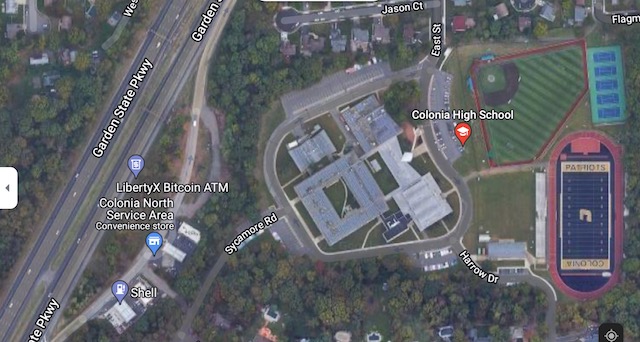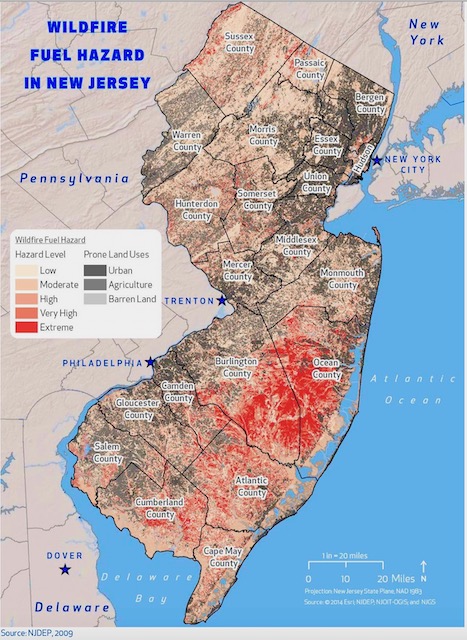Climate Policy Must Shift From Costly Incentives & Corporate Subsidies To Mandates
All Carrots And No Sticks Can Not Work
Corporate Funded Magical Thinking At Princeton Would Stoke More Gas & PSE&G Profits
Yesterday, the NJ Senate Environment Committee announced its annual Earth Day Legislative hearing agenda.
The good news is that it’s better than last year’s debacle designed to promote logging of NJ forests, see:
But the bad news is that, although it addresses the (undeclared in NJ by Gov. Murphy) climate emergency, the agenda seems narrowly limited to “climate adaptation”, ignores the need for deep and rapid reductions in greenhouse gas emissions and is limited to “invited guests”.
The Committee will meet to hear testimony from invited guests on strategies that the State and industries could implement in order to adapt to and mitigate the effects of climate change.
Curiously, Chairman Smith has yet to post his own GHG emissions reduction bill, co-sponsored by Senator Greenstein, S1602, which “Authorizes regulation of greenhouse gas emissions under “Air Pollution Control Act (1954)” and “Global Warming Response Act. (for analysis of that, see:
What is Smith waiting for?
As you will recall, back on February 10, the Committee took testimony on the climate emergency from just 2 “invited guests”: DEP Commissioner LaTourette and BPU President Joe Fiordaliso. I called that stunt out, with this post:
NJ BPU President Fiordaliso and DEP Commissioner LaTourette were the only “invited guests” to testify. No scientists. No climate or energy experts. No climate activists or environmentalists. Pure political theater.
The hearing was actually worse than I expected, in terms of being a political show and opportunity for the Murphy administration to respond to critics. This was not legislative oversight, this was legislative press event.
At the close of that hearing, realizing that the DEP & BPU testimony lacked substance and was vague Kabuki, Chairman Smith stated that he was inviting climate scientists to testify at a followup hearing.
When will the public and climate activists be “invited” to testify?
Upon learning of the April 21 hearing yesterday, I immediately sent Chairman Smith an email (mistakenly) questioning the narrow focus on adaptation and recommending that he expand the agenda to include emissions reductions.
This morning, I was researching and preparing to write a post blasting Chairman Smith for failure to conduct that hearing on emissions reductions.
But I am embarrassed now to admit that I somehow missed that Senate followup hearing email notice because I was on the road and off line at the time.
This morning, I just now learned that the followup hearing was held on March 14, 2022. The topic of that hearing was:
The committee will meet to hear testimony from invited guests on what actions the State should take to achieve net-zero greenhouse gas emissions by 2050, and the cost of those actions to ratepayers.
(listen here – I am unable to open the audio player).
Here is a transcript of the hearing.
I) Corporate Funded Magical Thinking At Princeton
The Senate’s scientists and “invited guests” were limited to one Princeton assistant professor of engineering, who presented a technocratic and economic modeling exercise, designed to optimize the “least cost” scenario. The study is titled:
Once again, the focus on “costs” ignores benefits, as well as other non-energy consumer “costs” people pay. Logically, costs are only relevant in relationship to benefits. Investments are not “costs”. Public goods are not consumer commodities or allocated by market forces. Market prices do not consider “external costs” (social, environmental, or public health) or reflect the true price of energy. And not all relevant policy considerations are assigned a market price or are amenable to “modeling”.
I’ll obviously need to review that Princeton study in detail and will write about it in a future post. But I found this Princeton testimony about the study interesting:
Excluded in our totals are distribution network costs, retailing and hedging costs, and other policy charges that might be included in retail bills as well.
Also excluded, implicitly and without explicit disclosure, are corporate profits (e.g. explicit rate of return on investment).
I also found this interesting:
Second, though we find the lowest cost strategy, to reach 100 percent carbon-free electricity entails a significant increase in New Jersey’s dependence on imported electricity. Imports of wind, solar, and other carbon-free resources from out of state are generally more affordable than available in-state resources, and so make up about two-thirds of New Jersey’s electricity supply by 2050 in our least-cost strategy.
PSE&G makes its highest profits on transmission – like imports of electricity.
According to NJ Spotlight – who also is funded by PSE&G – the Princeton modeling Report was funded by PSE&G.
But PSE&G not only funded it, but had a role in pre-publication reviewing and drafting:
• Funding: This project was supported by a grant from Public Service Enterprise Group (PSEG).
• Acknowledgements: The authors wish to acknowledge members of the PSEG energy team for thoughtful comments and inputs on earlier drafts of this report.
This finding is probably the most controversial finding and quite revealing of the real agenda:
If we take a look at some of the key technology options that New Jersey faces, our study finds the following: The least-cost pathway to 100 percent carbon-free electricity supply for New Jersey entails a substantial expansion of utility-scale solar resources; new gas-fired generating capacity, mostly efficient combined cycle power plants; and conversion of all of these gas plants to run on zero-carbon fuels by 2050. That could include some combination of hydrogen, biomethane or biogas, or synthetic methane produced from carbon-free or carbon neutral sources;
Again, it just so happens that PSE&G makes large profits in “utility scale solar” (as opposed to rooftop solar). “Utility scale” industrial solar is destroying what’s left of NJ’s farms and forests.
[Update: 4/20/22 – According to a NJ Spotlight story today, PSE&G has divested from solar. I stand corrected. Apologies for error.]
“New gas fired generating capacity” means even more fracking, pipelines, compressor stations, and power plants, which directly contradict GHG emissions reductions goals and climate activists’ demands for a moratorium on new fossil infrastructure.
Here’s another revealing pro-gas finding –
We looked closely at the role of New Jersey’s existing nuclear plants, and concluded that preserving New Jersey’s nuclear generators can reduce dependence on imports, and avoid an increase in fossil gas generation — and associated CO2 emissions and air pollution — that might otherwise occur in the 2030s when those nuclear plants retire and are replaced, in part, by natural gas generation.
Relatedly, PSE&G received huge $300 million/year nuclear plant subsidies – the Report recommends more of that, again to the benefit of PSE&G:
Supporting continued operation of New Jersey reactors after 2030 is consistently among the lowest cost options for in-state carbon-free generation. But we stress it would require ongoing policy support after 2030, when the current Zero-Emissions Certificates Program ends.
And this is another pro-corporate profit – pro-PSE&G recommendation:
We find that utility-scale solar is considerably lower cost than the distributed resources that have typically been supported by State policy. Expanding large utility-scale solar projects is part of the least-cost portfolio in all of our scenarios.
The Princeton Report even goes out of its way to slam rooftop solar:
I wanted to note that this study is limited in scope to modeling the wholesale electricity system at the transmission level, so distributed solar systems can result in additional costs and/or savings at the distribution level, depending on the pattern and scale of deployment, and these impacts are not assessed but are important to consider when we look at distributed solar.
And this finding exposes some of the myths of renewable power. Some Murphy “green” cheerleaders have claimed that off shore wind displaces carbon power. That is not true – just the opposite is the case, where renewables serve huge growth in electricity demand and even fossil power increases:
We also find that electricity demand could grow significantly, with total sales increasing by 70 percent, and peak demand increasing by 85 percent, as electrification of vehicles and buildings proceeds, consistent with New Jersey’s economy-wide climate goals. […]
Gas-fired capacity, or the ability to produce power when needed, is needed to meet growing demand from electrification as we turn more to electric vehicles and heat pumps.
For a solid analysis of how renewables serve new demand growth, see:
And here is the fatally flawed assumptions – magical thinking – the whole analysis relies upon: a zero carbon fuel does that not exist and a carbon removal technology that is not feasible or even commercially available:
By 2050, these resources would all have to be converted to run on some zero-carbon fuel; or, if we pursue a carbon neutrality approach, any residual emissions would have to be offset by carbon removal technologies by 2050, when 100 percent carbon neutral electricity is required.
Of course, there’s more PSE&G profits buried in the findings:
Finally, New Jersey will need to expand our transmission capacity to increase deliverability between coastal and inland areas in the near term, in order to integrate the offshore wind that we’re planning to deploy on the coast; as well as to significantly strengthen ties to neighboring regions, states in PJM, and New York in the longer term, in order to enable greater imports.
But I guess I missed the boat big time on that Report and hearing and must apologize to Smith for implying that he crafted an arbitrarily narrow “adaptation” agenda.
II) ADAPTATION
But while we’re on the adaption issue, I’ve recently posted these warnings:
Here is my email to Smith, with adaptation recommendations.
Most importantly, I recommend that State policymakers dramatically shift the current approach from market based inventive and subsidies (carrots) to legislative and regulatory mandates (sticks):
Greetings – please accept the below as testimony to enter into the record for the subject hearing:
1. The focus of the hearing on adaptation must be expanded to include emissions reduction strategies and regulations. Such a focus is timely, in light of the DEP’s proposed flawed CO2 emissions reduction rule and upcoming climate PACT rules.
2. The way to accomplish that expanded focus is to post Chairman Smith’s bill, co-sponsored by Senator Greenstein, S1602, which “Authorizes regulation of greenhouse gas emissions under “Air Pollution Control Act (1954)” and “Global Warming Response Act.
https://www.njleg.state.nj.us/Bills/2022/S2000/1602_I1.PDF
3. With respect to the adaptation issue,I submit a recent petition for ruelmaking I filed with DEP, The Pinelands Commission, and Highlands Council with respect to land use and development controls to reduce wildfire risks. That petition is based on testimony during the Committee’s February 10, 2022 hearing, see
https://www.nj.gov/njhighlands/act/rules/petitions/rule_petition_20220309.pdf
4. I strongly urge the Committee to reject any recommendations that relate to “active forest management” – other than carbon sequestration, afforestation, reforestation, and urban forestry, which I strongly support – as an adaptation strategy.
5. I urge the Committee to support specific legislative mandates to require electric conversion of new and existing buildings.
6. I urge the Committee to reconsider the current market based and incentive/subsidy approach to both climate adaptation and emissions mitigation (reduction). Instead of these voluntary and expensive strategies (carrots), I urge adoption of mandates and regulatory enforcement (stick).
7. I urge the Committee to consider legislation to adopt a policy of “strategic retreat”, which would include:
a) adoption of the 500 year storm interval as a surrogate for projected climate impacts and repeal of the current 100 year storm in current law and regulation;
b) prohibitions and new more stringent restrictions on existing and new development on lands projected to be inundated, subject to storm surge and/or sea level rise, or flooding, based on the 500 year storm event;
c) repeal of current laws that allow rebuilding of storm or flood damaged properties (e.g. in the Flood Hazard Control Act and CAFRA).
The above recommendations ar based on the best available current science and are necessary. They would be a serious beginning and strong first step to address the accelerating climate emergency.

